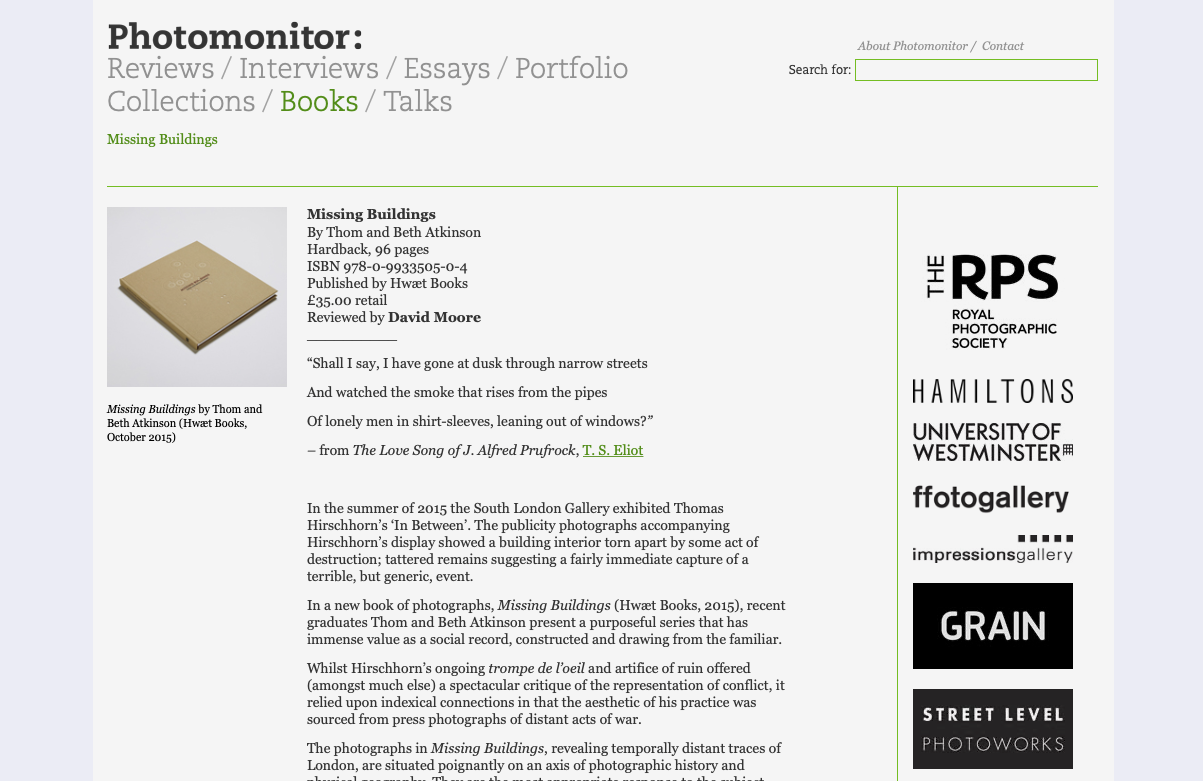Reviews
Often, the best ideas are also the simplest. When I first saw Thom and Beth Atkinson’s pictures of missing buildings - and the wonderful map that accompanies them - I have to admit I felt a tad envious of their idea. For this is a true ‘photographic’ project, better made with still pictures than any other medium, and with a clearly defined, evocative subject matter.
Sometimes, unfortunately, the best laid plans are failed by disappointing images, but not in this case. I’m very pleased to say that (envy apart!) Thom and Beth’s photographs, and the strategy they have employed, do perfect justice to the idea.
- Mark Power
‘Missing Buildings’ has the directness of all the best photography. As a born Londoner
I feel it encapsulates something I have experienced subconsciously all my life and put it into images. I was brought up in a street in Paddington with spaces where houses had been bombed. By focusing on what’s not there, Beth and Thom Atkinson have found a profound way to make images that depict what is there, the remains of a terrible war.
- Peter Kennard
Growing up in Britain in the 1950's meant journeying through cities still full of bomb craters, piles of rubble, vacant lots and the fascinating spectacle of homes sheered off along one end. Wallpapers, doorways, fireplaces were all exposed and added a surreal and almost decorative element to the urban environment. That so many such sites may still exist has been brought home to me recently by the brilliant typological series sought out and photographed by Thom and Beth Atkinson.
- Jem Southam
One of the most eagerly awaited books of 2015.
- Photobook Bristol
Cities are shaped as much by what is not present, what does not persist, as what does. The traces and absences. The missing links and voids. About history and memory we might say something similar. Disappearance frames appearance, giving shape to what we can recover, often in startling ways.
The bombing of London in the Second World War transformed the place in a matter of months. It also transformed perceptions. The photographer Nigel Henderson recalled: “Surrealism was everywhere in a sense. Houses chopped by bombs while ladies were still sitting on the lavatory, the rest of the house gone but the wallpaper and fires still burning in the grate. Who can hold a candle to that kind of real life Surrealism?” Similarly, the film editor Dai Vaughan noted: “In a bombed hospital, an umbrella might well encounter a sewing machine on a dissecting table. If the goal of surrealism was 'changer la vie', life was now changing before everyone’s eyes… generating imagery at a pace which left the artist no need to trawl his or her subconscious for symbols of flux and transcendence. Surrealism and the documentary imperative were united.”
To the trained eye London is still full of those strange shocks. Time has barely softened them. We don’t use the term ‘surreal’ much any more. It’s either too art historical, or debased by the mass media. But those who intuit the essence of the surreal know it cannot be contained, nor consigned to history. It resurfaces just where and when you least expect. Thom and Beth Atkinson’s documents of London’s missing buildings seem to me surreal in the truest and most profound way.
- David Campany














